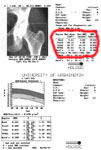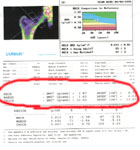



| 
| 
|

The data on areas and BMCs are usually ignored, but sometimes they are important. The area is the projected area that is measured, defined by the computer tracing the borders of the bone, or the technologist tracing an area. The BMC is the bone mineral content within that area.
When a patient has a follow-up scan with results that seem out of line, it is helpful to see if the areas measured were similar in each scan.

The BMD for each vertebra is the BMC/area. For the entire L1-L4 region, it is the SUM of the BMCs for L1-4 divided by the SUM of the areas. (It is not just the average of the 4 vertebrae). Sometimes there has been a compression in one vertebra, or a surgical change, or technical problem that makes one unreadable. The other 3 can still be used to estimate the BMD by hand-calculations from the BMCs and areas.
In young or small patients, the BMAD can be helpful. This is discussed on the next page. The areas and mineral contents are needed to calculate the BMAD.
The BMC and area measurements for Lunar spine scans are usually printed on a separate sheet of paper.
In cases of very low bone density, the DEXA edge-detection system does not recognize some of the pixels as bone. So the area will be lower than the actual area of the vertebra. If these patients are sucessfully treated, the area may become larger even though the bone did not really get bigger. The results can become quite misleading.

